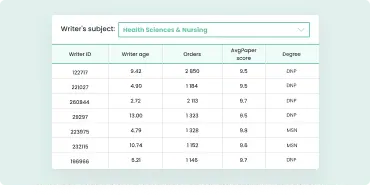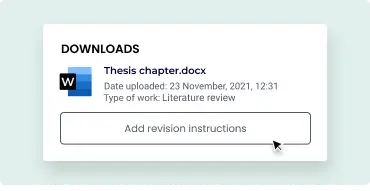Take the Stress Out of Making a Thesis Outline by Entrusting It to Us
Get reliable assistance writing a thesis outline from our best Ph.D. experts and show your future project in the best light.
What you gain by entrusting your thesis outline to us
Don’t stress about your outline for thesis with our writing service
Our writing services are completely secure – we've taken the most cutting-edge precautions to ensure that you're never compromised when writing a thesis outline with us.
-
 Intellectual property protection
Intellectual property protectionThe completed project belongs exclusively to you. We never resell or reuse already-written works from our databases.

-
 Privacy assurance
Privacy assuranceOur professional writing service adheres to strict confidentiality standards through our privacy policy, CCPA & GDPR compliance, and SSL encryption.

-
 Secure payments
Secure paymentsSafely pay for the outline of thesis using all popular credit/debit cards. We utilize Solid and Ecommpay gateways to ensure the security of your data.

Meet the experts who can help at any stage of writing a thesis outline
Customer’s reviews on our 'write thesis outline' service
How to Write a Thesis Outline and Everything You Need to Know
If you’re getting ready to finish your studies, your professor will definitely ask you to submit a thesis related to your field of research. When it comes to projects such as a thesis, it’s helpful to create an outline. It ensures that you cover all of the essential points without missing a thing. But wait a minute! Do you know what it is and how to make it effective? If not, keep reading to find out!
What Is a Thesis Paper Outline
Usually 3 to 5 pages long, an outline is a plan that guides you through the process of crafting your Master’s or Ph.D.-level work. It helps organize your main points and acts as a roadmap for deciding on the type of research you want to conduct. Put simply, it’s a framework for your project where you list arguments and subtopics in a logical order. Just like choosing a relevant topic, having a plan is essential for crafting a well-structured and well-researched academic paper. It’s a truly indispensable tool that can help you:
- Stay organized: It breaks down your thesis into smaller sections, making planning your research and writing much easier.
- Keep a logical flow: It ensures your content makes sense, with each part leading to the next.
- Avoid repeating or adding extra things: It helps you focus on what’s important and not include things that aren’t needed.
- Meet your institution’s guidelines: Many institutions have specific guidelines, and a plan makes sure your thesis follows them to the letter.
- Get feedback: It makes it easier for advisors or committee members to give suggestions for making your project better.
Now that you know the fundamentals, let’s focus on thesis outline structure and how to write one.
Thesis Outline Structure: Essential Components
A standard thesis outline example typically consists of three main parts (the introduction, the body divided into subsections, and a conclusion) and a few additional, no less important parts. Each part serves a particular purpose and contributes to the overall structure and coherence of the project. Let’s now focus on each part separately:
- Title page
This is the first page, which includes the title of the thesis, the author’s name, the department, the institution, and the date it was handed in.
- Summary
A summary is a short sum-up of the paper. It is where you present the main points and findings. Usually, it’s around 150-300 words.
- Contents page
This page lists all the chapters and sections of the thesis with page numbers.
- Introduction
This part is a starting point of the project that discusses the topic, the main question or idea, and how the research will be done.
- Research background
The research background section states what other academicians have said about the topic before, pointing out any gaps or things they don’t agree on.
- How the research is done
This part explains the research plan (e.g., how it is conducted, and how information is collected and analyzed).
- Results
The results typically show what’s found during the research, using tables, charts, and graphs to help understand the information more easily.
- Discussion
Here, the results are explained and connected to the main question. This section also explains what the results might mean for the future research work.
- Conclusion
This is where everything is summarized, the main question or idea is restated, and the final thoughts are shared.
- References
The references list all the books, articles, and other scholarly sources used in your research project.
- Extras
In this section, you’re expected to present additional material, like surveys or data, that’s important but not included in the main part of the thesis.
Writing a Master’s Thesis Outline: 7 Top Tips From Our Pros
When writing a master’s thesis outline, consider the following tips for a smooth and organized process:
- Know what your work is about. Before starting, clearly understand the focus of your research and the objectives you aim to achieve.
- Arrange your ideas. Structure your thesis into distinct sections, including an introduction, literature review, methodology, results, discussion, and conclusion. Think about what each part will discuss and how they all connect.
- Summarize each part. As you write each section, come up with a brief summary encapsulating the main ideas. This practice will help maintain focus and prevent the inclusion of unnecessary information.
- Make a table of contents. Develop a comprehensive table of contents listing all main sections and subsections along with corresponding page numbers. This will serve as a clear and organized roadmap for your project.
- Start by creating a hypothesis. Once done, position your hypothesis at the top of your page. Then, relate the rest of your content to it in the order you outlined. You can use keywords, sentences, and phrases in your initial draft instead of detailed information.
- Review and change. Once you write thesis outline, check if it makes sense and flows well. Adjust it to match what you really want to say in your thesis.
- Share your draft with your advisor or committee members to receive valuable suggestions and refine your plan further. Alternatively, you can hire a custom thesis writing service to polish your work to perfection and submit it with confidence.
Verbs to Use in Your Outline
As you’re creating a thesis outline, you might find yourself repeating the same verbs, such as “present,” “discuss,” or “show.” A good idea is to use synonyms to add richness to your work.
Below are some alternatives you can consider:
- Argue
- Address
- Clarify
- Concern
- Compare
- Determine
- Describe
- Examine
- Explain
- Focus on
- Formulate
- Give
- Highlight
- Imply
- Indicate
- Point out
- Propose
- Refute
- Report
- Recommend
- Speculate
- Summarize
- Target
We hope this guide on how to write a thesis outline will help you create an ideal plan for your project. Still, if you have any doubts as you get ready for your best thesis defense, consult your professor or reach out to us. At thesiswritingservice.com, our Ph.D. experts can help you write an outstanding outline in strict compliance with your guidelines. Additionally, our service can advise you on how to write acknowledgement for thesis or help you complete the entire project from scratch.


























